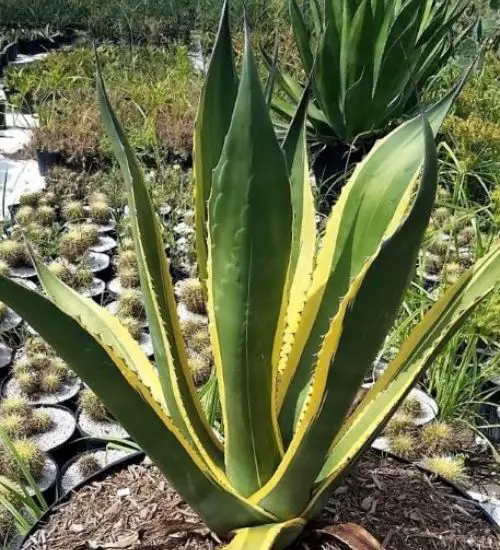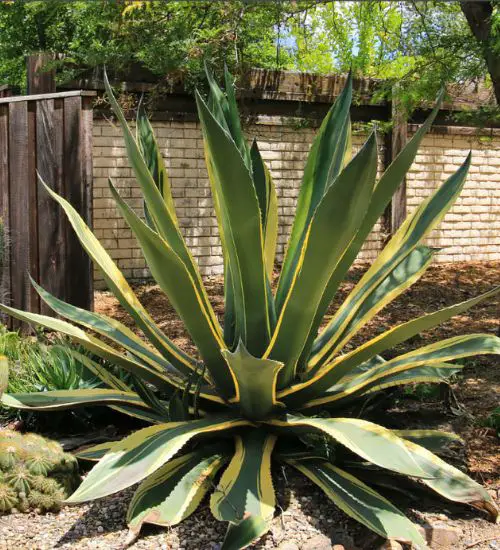Sun: Full sun to light shade
Water: Typical water needs for a succulent
Temperature: Zone 8b from 15° F to 20° F (-9.4° C to -6.7° C) to Zone 11b from 45° F to 50° F (7.2° C to 10° C)
Winter Survival: Cold hardy
Propagation: leaves, offsets, cuttings, seeds
Flower: In the Spring
Flower Type: Yellow
Toxic: Toxic to humans and animals
Dormant: winter
Space Requirement: Outdoors
Common Problems: No major pests, Plants may rot if overwatered
Basc Care for Agave salmiana Variegata
Watering
You can water your succulent more than often in extreme conditions but make sure that the soil is completely dry before watering your succulent again.
One simple tip for you is that you can use some online apps to check the soil status before you go water your succulents. I would recommend the ThePlantsCheck app, it has some nice features there.
Fertilizing
Only feed this succulent during its active growing seasons which means no information. Use the right fertilizer applied in the right amounts. Applying half-strength balanced fertilizer every month or so is recommended for optimal results.
Do not fertilize during winter as the plant is dormant.
Sun & Location Requirements for "Agave salmiana Variegata"
Agave salmiana Variegata thrives in full sun to light shade. This means that it should be exposed to direct sunlight for most of the day for optimal growth and health. Make sure your succulent is placed in a spot where it will receive no more than 5 hours of shade each day.
As per this succulent profile, it is only able to stay healthy when the environment temperature is above the range of zone 8b from 15° F to 20° F (-9.4° C to -6.7° C).
Agave salmiana Variegata is one of the most cold hardy succulents available, capable of surviving temperatures down to 0°F. Its thick leaves and stems help retain moisture in its cells and protect it from frigid winter weather. The succulent's attractive foliage adds a touch of cheerfulness to any cold-weather garden. Agave salmiana Variegata is an ideal choice for areas with freezing temperatures during the winter months.
Any succulents in the group will need a large space to grow. You should place your pot outdoor. Since this plant needs a lot of space than other succulents, you should consider not planting them together with other succulents/plants.
Agave salmiana Variegata also benefits from some indirect light throughout the day as well, so make sure you give it enough space to soak up light without becoming too exposed to heat.
Propagation
Propagating succulents from leaves is an easy and cost-effective way to grow new plants. All you need are a few healthy leaves from the mother plant, some potting mix, and regular watering. After a few weeks you'll have brand new succulents that you can watch grow!
Propagating with offsets is a great way to get more plants from the same mother plant. All you have to do is cut away an offset and pot it in soil, and soon enough you’ll have a brand-new Agave salmiana Variegata!
One way to propagate Agave salmiana Variegata is by cutting
Propagating Agave salmiana Variegata from seeds is a great way to produce new plants without relying on cuttings or divisions. It's important to look for healthy, dark and plump seeds that are slightly sticky when touched. The soil should be pre-mixed with well-draining potting mix, before evenly sowing the seeds and pressing them into the surface. To ensure successful germination, gentle misting of the soil should be done and placed in indirect light.
Toxicity

All parts of Agave salmiana Variegata are considered to be poisonous, and should never be ingested. Even contact with the sap can cause serious skin irritations in humans and animals, so it’s important to wear gloves when handling them.
Pests and Diseases
Agave salmiana Variegata is not affected too much by common pests and diseases like most of the other succulents.


